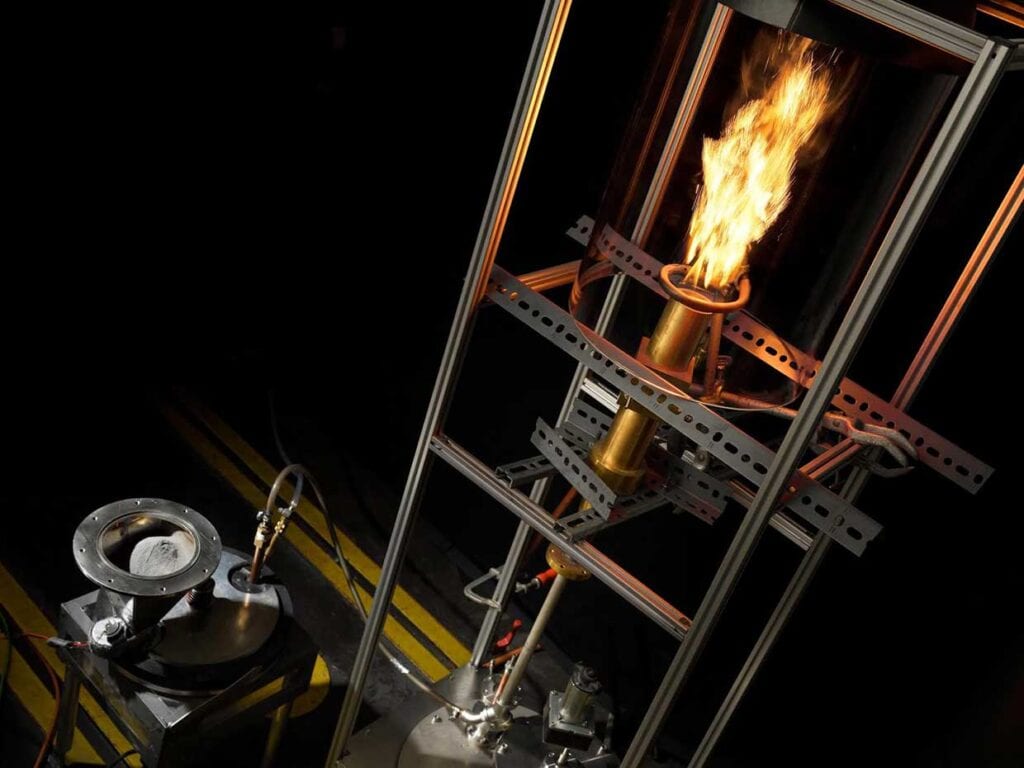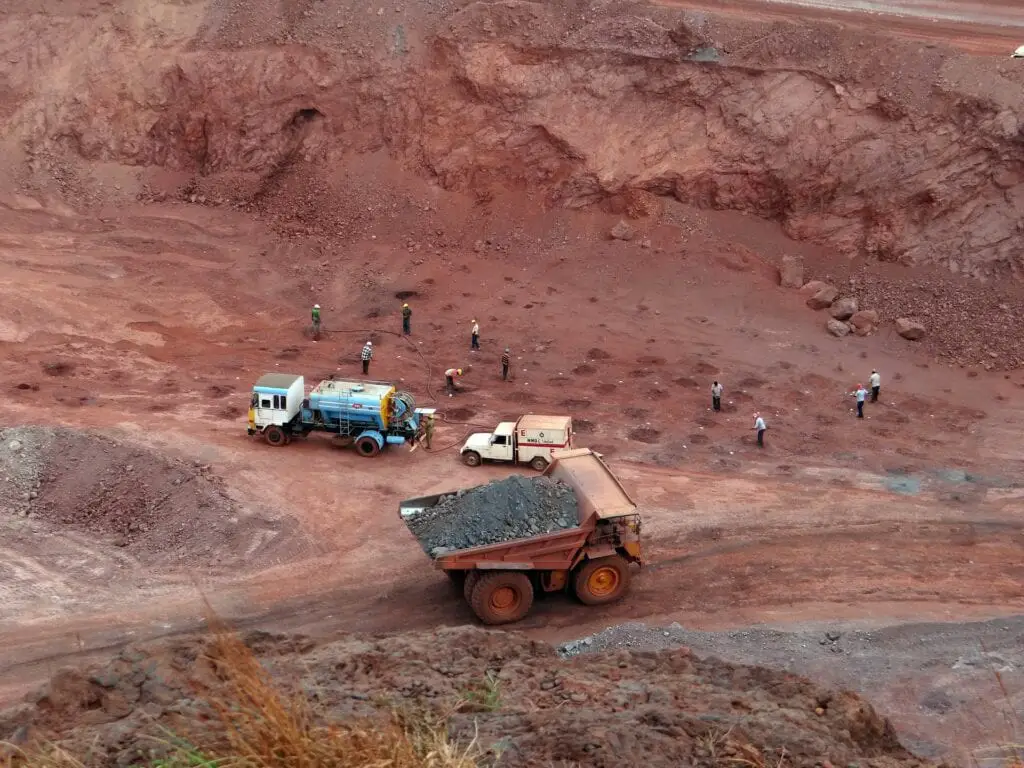Oxidizing and reducing powdered iron has the potential to provide clean power on an industrial scale…
We’re not short of ways to generate power. But, as any conservative politician will tell you, we’re short on ways to generate reliable, ‘base load’ power, 24 hours a day, seven days a week.
They argue that wind and solar are unreliable; that battery storage is far to expensive; that to stop burning coal would cripple economies even more than COVID-19 has.
What if we could end this whole fossil fuel-fed climate change nightmare and burn something else as an energy source instead?
As a bonus, what if that something else is one of the most common elements on Earth?
Let’s burn iron!
OK, so setting fire to an iron ingot is probably more trouble than it’s worth but fine iron powder mixed with air is highly and readily combustible.
When you burn this mixture, you’re actually oxidizing the iron. Whereas a carbon fuel oxidizes into CO2, an iron fuel oxidizes into Fe2O3, which – wait for it – plain old, everyday, rust!
The nice thing about rust is that it’s a solid. It can be easily captured post-combustion. It doesn’t rise into the atmosphere… it falls to teh ground.
And rust is the only byproduct of the entire process — in goes the iron powder and out comes energy in the form of heat and rust powder.
Iron has an energy density of about 11.3 kWh/L, which is better than gasoline. Although its specific energy is a relatively poor 1.4 kWh/kg, meaning that for a given amount of energy, iron powder will take up a little bit less space than gasoline but it’ll be almost ten times heavier.
It might not be suitable for powering your car, in other words. It probably won’t heat your house either. But it could be ideal for industry, which is where it’s being tested right now.
Researchers from TU Eindhoven have been developing iron powder as a practical fuel for the past several years, and last month they installed an iron powder heating system at a brewery in the Netherlands, which is turning all that stored up energy into beer. Since electricity can’t efficiently produce the kind of heat required for many industrial applications (brewing included), iron powder is a viable zero-carbon option, with only rust left over.

Photo: Bart van Overbeeke
So what happens to all that rust? This is where things get clever, because the iron isn’t just a fuel that’s consumed— it’s energy storage that can be recharged. And to recharge it, you take all that Fe2O3, strip out the oxygen, and turn it back into Fe, ready to be burned again. It’s not easy to do this, but much of the energy and work that it takes to pry those Os away from the Fes get returned to you when you burn the Fe the next time. The idea is that you can use the same iron over and over again, discharging it and recharging it just like you would a battery.
To maintain the zero-carbon nature of the iron fuel, the recharging process has to be zero-carbon as well. There are a variety of different ways of using electricity to turn rust back into iron, and a consortium led by TU/e researchers is exploring three different technologies based on hot hydrogen reduction (which turns iron oxide and hydrogen into iron and water), as they described to IEEE Spectrum in an email:
Mesh Belt Furnace: In the mesh belt furnace the iron oxide is transported by a conveyor belt through a furnace in which hydrogen is added at 800-1000°C. The iron oxide is reduced to iron, which sticks together because of the heat, resulting in a layer of iron. This can then be ground up to obtain iron powder.
Fluidized Bed Reactor: This is a conventional reactor type, but its use in hydrogen reduction of iron oxide is new. In the fluidized bed reactor the reaction is carried out at lower temperatures around 600°C, avoiding sticking, but taking longer.
Entrained Flow Reactor: The entrained flow reactor is an attempt to implement flash ironmaking technology. This method performs the reaction at high temperatures, 1100-1400°C, by blowing the iron oxide through a reaction chamber together with the hydrogen flow to avoid sticking. This might be a good solution, but it is a new technology and has yet to be proven.
Both production of the hydrogen and the heat necessary to run the furnace or the reactors require energy, of course, but it’s grid energy that can come from renewable sources.
If renewing the iron fuel requires hydrogen, an obvious question is why not just use hydrogen as a zero-carbon fuel in the first place? The problem with hydrogen is that as an energy storage medium, it’s super annoying to deal with, since storing useful amounts of it generally involves high pressure and extreme cold. In a localized industrial setting (like you’d have in your rust reduction plant) this isn’t as big of a deal, but once you start trying to distribute it, it becomes a real headache. Iron powder, on the other hand, is safe to handle, stores indefinitely, and can be easily moved with existing bulk carriers like rail.
Which is why its future looks to be in applications where weight is not a primary concern and collection of the rust is feasible. In addition to industrial heat generation (which will eventually include retrofitting coal-fired power plants to burn iron powder instead), the TU/e researchers are exploring whether iron powder could be used as fuel for large cargo ships, which are extraordinarily dirty carbon emitters that are also designed to carry a lot of weight.
Philip de Goey, a professor of combustion technology at TU/e, told us that he hopes to be able to deploy 10 MW iron powder high-temperature heat systems for industry within the next four years, with 10 years to the first coal power plant conversion. There are still challenges, de Goey tells us: “the technology needs refinement and development, the market for metal powders needs to be scaled up, and metal powders have to be part of the future energy system and regarded as safe and clean alternative.” De Goey’s view is that iron powder has a significant but well-constrained role in energy storage, transport, and production that complements other zero-carbon sources like hydrogen. For a zero carbon energy future, de Goey says, “there is no winner or loser— we need them all.”
While we all need to be very aware of the damage our current emissions are doing to our world, there is every reason to believe that technology can give us the future our kids and their kids need.






